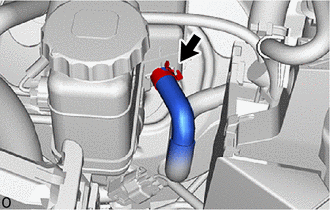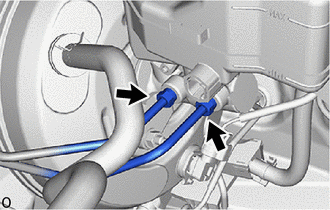Toyota Yaris: Brake Master Cylinder / Removal
REMOVAL
CAUTION / NOTICE / HINT
The necessary procedures (adjustment, calibration, initialization, or registration) that must be performed after parts are removed, installed, or replaced during the brake master cylinder sub-assembly removal/installation are shown below.
NOTICE:
Make sure to release vacuum from the brake booster assembly before removing the brake master cylinder sub-assembly from the brake booster assembly.
HINT:
When the cable is disconnected / reconnected to the auxiliary battery terminal, systems temporarily stop operating. However, each system has a function that completes learning the first time the system is used.
-
Learning completes when vehicle is driven
Effect/Inoperative Function When Necessary Procedures are not Performed
Necessary Procedures
Link
Lane tracing assist system
Drive the vehicle straight ahead at 35 km/h (22 mph) or more for 5 second or more.

Pre-collision system
Stop and start system
Drive the vehicle until stop and start control is permitted (approximately 5 to 60 minutes)

-
Learning completes when vehicle is operated normally
Effect/Inoperative Function When Necessary Procedures are not Performed
Necessary Procedures
Link
Power door lock control system
- Back door opener
Perform door unlock operation with door control switch or electrical key transmitter sub-assembly switch.

Air conditioning system
After the ignition switch is turned to ON, the servo motor standard position is recognized.
-
PROCEDURE
1. REMOVE WINDSHIELD WIPER MOTOR AND LINK ASSEMBLY
Click here

2. REMOVE FRONT NO. 1 VENTILATOR SEAL
Click here

3. REMOVE WATER GUARD PLATE RH
Click here

4. REMOVE OUTER COWL TOP PANEL SUB-ASSEMBLY
Click here

5. REMOVE ECM
Click here

6. DRAIN BRAKE FLUID
NOTICE:
If brake fluid leaks onto any painted surface, immediately wash it off.
7. DISCONNECT NO. 1 CLUTCH RESERVOIR HOSE
| (a) Slide the clip and disconnect the No. 1 clutch reservoir hose from the brake master cylinder reservoir assembly. |
|
8. REMOVE BRAKE MASTER CYLINDER SUB-ASSEMBLY
| (a) Disconnect the connector from the brake master cylinder reservoir assembly. |
|
(b) Disengage the 2 clamps from the brake master cylinder reservoir assembly.
| (c) Using a union nut wrench, disconnect the 2 brake lines from the brake master cylinder sub-assembly. NOTICE:
|
|
| (d) Remove the 2 nuts and brake master cylinder sub-assembly from the brake booster assembly. NOTICE:
|
|
9. REMOVE BRAKE MASTER CYLINDER O-RING
(a) Remove the brake master cylinder O-ring from the brake master cylinder sub-assembly.
 Components
Components
COMPONENTS ILLUSTRATION
*1 FRONT NO. 1 VENTILATOR SEAL *2 WATER GUARD PLATE RH *3 OUTER COWL TOP PANEL SUB-ASSEMBLY - -
N*m (kgf*cm, ft...
 Disassembly
Disassembly
DISASSEMBLY PROCEDURE 1. REMOVE BRAKE MASTER CYLINDER RING PIN (a) Secure the brake master cylinder sub-assembly in a vise. NOTICE: Place aluminum plates on the vise to prevent damage to the brake master cylinder sub-assembly...
Other information:
Toyota Yaris XP210 (2020-2025) Reapir and Service Manual: Starter Inrush Current Reduction Relay Circuit
DESCRIPTION The starter inrush current reduction relay prevents the auxiliary battery voltage from becoming dropping excessively while the starter assembly is operating. If the auxiliary battery voltage drops below the threshold, stop and start control will be prohibited...
Toyota Yaris XP210 (2020-2025) Reapir and Service Manual: Brake Line
PrecautionPRECAUTION TROUBLESHOOTING PRECAUTION NOTICE: Since the brake lines are critical safety related parts, be sure to disassemble and inspect the components if a brake fluid leak is found. If any abnormalities are found, replace the component with a new one...
Categories
- Manuals Home
- Toyota Yaris Owners Manual
- Toyota Yaris Service Manual
- Diagnostic Trouble Code Chart
- Battery Monitor Module General Electrical Failure (P058A01)
- Maintenance
- New on site
- Most important about car
Break-In Period
No special break-in is necessary, but a few precautions in the first 600 miles (1,000 km) may add to the performance, economy, and life of the vehicle.
Do not race the engine. Do not maintain one constant speed, either slow or fast, for a long period of time. Do not drive constantly at full-throttle or high engine rpm for extended periods of time. Avoid unnecessary hard stops. Avoid full-throttle starts.



